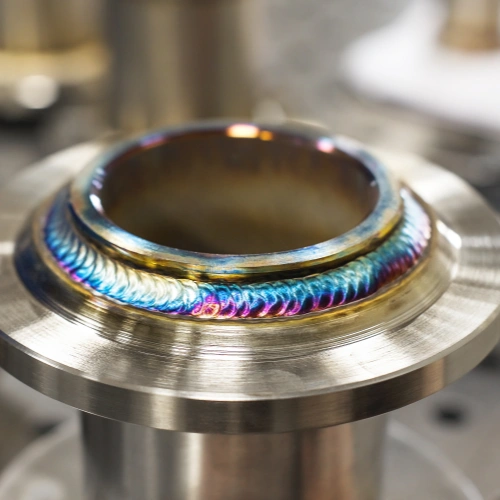Understanding Welding Discoloration on Stainless Steel
Welding discoloration results from the formation of an oxide layer on the stainless steel surface due to excessive heat. The extent of discoloration depends on factors such as welding temperature, shielding gas effectiveness, and stainless steel grade.
The discoloration typically presents in different colors, each indicating the temperature at which oxidation occurred:
Light gold or yellow – Mild oxidation, generally forming at lower temperatures.
Blue or purple – Moderate oxidation, often seen in stainless steel exposed to higher heat levels.
Dark brown or black – Severe oxidation, which may require more intensive cleaning methods.
Understanding these variations helps in choosing the appropriate cleaning technique to restore the metal’s original finish.
Methods to Remove Welding Discoloration
1. Mechanical Cleaning
Mechanical cleaning involves physically removing the oxidized layer using abrasives.
Stainless Steel Brushes: Using a stainless steel wire brush can effectively scrub away light discoloration. It is crucial to use brushes specifically designed for stainless steel to prevent contamination.
Grinding and Polishing: For more severe discoloration, abrasive pads, sandpaper, or grinding wheels can be used to restore the surface. However, excessive grinding can alter the metal’s structure, so it should be done carefully.
Blasting Techniques: Abrasive blasting, such as glass bead or sandblasting, can remove discoloration while maintaining a smooth finish. This method is commonly used in industrial applications.
2. Chemical Cleaning (Pickling and Passivation)
Chemical cleaning is a highly effective way to remove welding discoloration without causing mechanical damage.
Pickling Paste: Pickling paste, which contains nitric and hydrofluoric acids, dissolves the oxidized layer. It is applied with a brush, left to react, and then rinsed thoroughly with water.
Passivation: After pickling, passivation with citric or nitric acid helps restore the stainless steel’s protective chromium oxide layer, enhancing corrosion resistance.
Precautions: Chemical cleaning should be performed in well-ventilated areas while using appropriate personal protective equipment (PPE), such as gloves and face shields.
3. Electrochemical Cleaning
Electrochemical cleaning uses an electric current and an electrolyte solution to remove oxidation efficiently.
Process: A conductive cleaning pad or brush is dipped in an electrolyte and applied to the discolored area while an electric current breaks down the oxide layer.
Advantages: This method is fast, environmentally friendly, and preserves the integrity of the metal surface.
Applications: Electrochemical cleaning is widely used in industries requiring high surface quality, such as food processing and pharmaceuticals.
4. Natural & Eco-Friendly Cleaning Methods
For those looking for non-toxic alternatives, eco-friendly solutions can also be effective.
Citric Acid Solutions: Citric acid-based cleaners can help remove light discoloration without harsh chemicals.
Baking Soda Paste: A paste made from baking soda and water can be applied to the affected area and scrubbed with a soft cloth to restore shine.
Vinegar and Lemon Juice: These mild acids can help break down oxidation, though they are best suited for light stains rather than severe discoloration.
Preventing Welding Discoloration
While removing discoloration is important, preventing it in the first place can save time and effort.
Proper Use of Shielding Gas: Inadequate shielding gas coverage allows oxygen exposure, leading to oxidation. Ensuring the correct gas flow rate and coverage helps minimize discoloration.
Controlling Heat Input: Excessive heat increases oxidation. Adjusting welding parameters, such as speed and voltage, can reduce unnecessary heat exposure.
Purging Techniques: For stainless steel pipes and tubes, using purging gases like argon prevents oxidation on the inside of the weld.
Post-Weld Treatments: Immediate cleaning and passivation after welding help preserve stainless steel’s appearance and durability.
Safety Tips When Cleaning Stainless Steel
Working with cleaning chemicals and mechanical tools requires proper safety measures.
Use of PPE: Always wear gloves, safety glasses, and protective clothing when handling pickling paste, acids, or abrasives.
Ventilation: Chemical treatments should be performed in well-ventilated areas to avoid inhaling toxic fumes.
Avoiding Contamination: Using dedicated stainless steel tools prevents cross-contamination, which can lead to rust formation.
Proper Waste Disposal: Ensure that chemical waste is disposed of according to local environmental regulations to prevent pollution.
Removing welding discoloration from stainless steel is essential for maintaining both aesthetics and corrosion resistance. Various methods, including mechanical cleaning, chemical treatments, and electrochemical techniques, offer effective solutions based on the severity of discoloration. Additionally, preventive measures such as proper shielding gas usage, heat control, and immediate post-weld treatments can minimize oxidation. By implementing the right cleaning and maintenance practices, stainless steel components can retain their quality and longevity. Whether using traditional pickling pastes, modern electrochemical methods, or eco-friendly alternatives, selecting the best approach ensures optimal results.
For industrial applications, consulting experts in stainless steel maintenance can help achieve the best outcomes while ensuring safety and efficiency.
